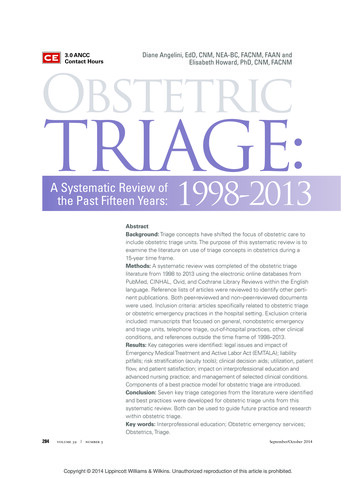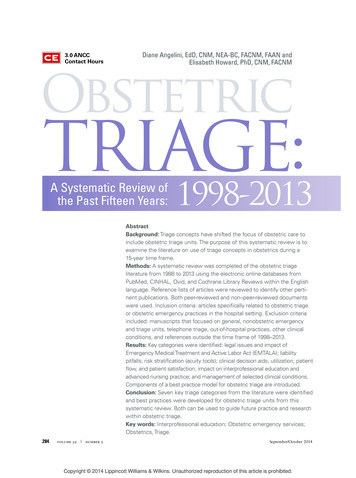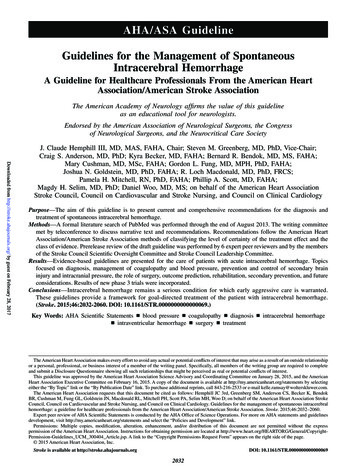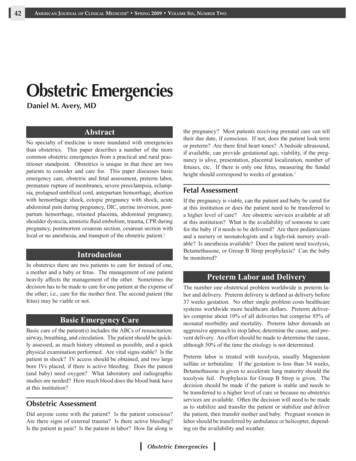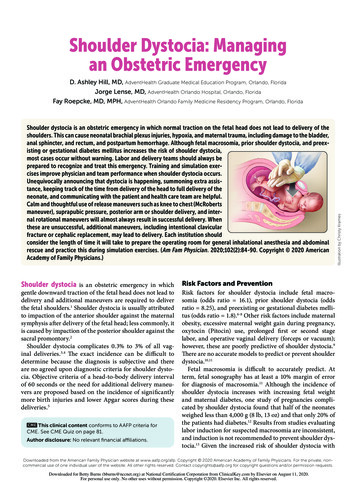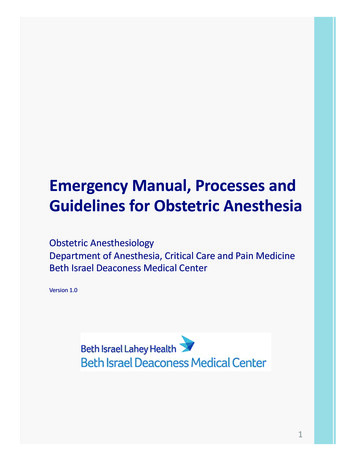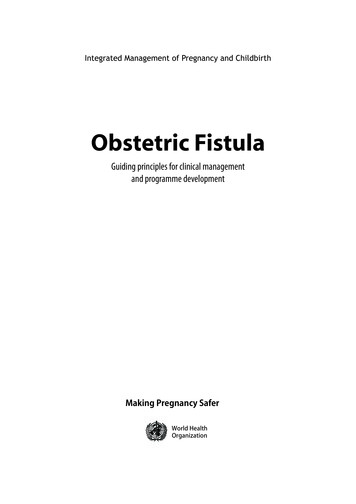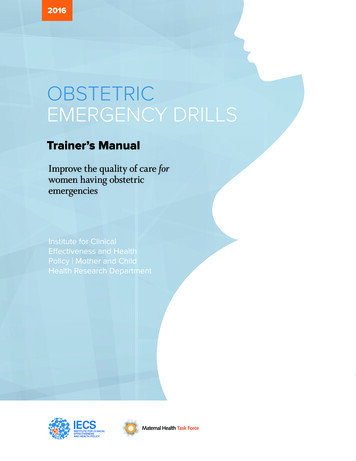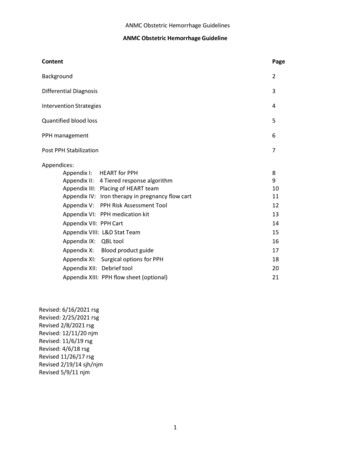
Transcription
ANMC Obstetric Hemorrhage GuidelinesANMC Obstetric Hemorrhage GuidelineContentPageBackground2Differential Diagnosis3Intervention Strategies4Quantified blood loss5PPH management6Post PPH Stabilization7Appendices:Appendix I: HEART for PPHAppendix II: 4 Tiered response algorithmAppendix III: Placing of HEART teamAppendix IV: Iron therapy in pregnancy flow cartAppendix V: PPH Risk Assessment ToolAppendix VI: PPH medication kitAppendix VII: PPH CartAppendix VIII: L&D Stat TeamAppendix IX: QBL toolAppendix X: Blood product guideAppendix XI: Surgical options for PPHAppendix XII: Debrief toolAppendix XIII: PPH flow sheet (optional)891011121314151617182021Revised: 6/16/2021 rsgRevised: 2/25/2021 rsgRevised 2/8/2021 rsgRevised: 12/11/20 njmRevised: 11/6/19 rsgRevised: 4/6/18 rsgRevised 11/26/17 rsgRevised 2/19/14 sjh/njmRevised 5/9/11 njm1
ANMC Obstetric Hemorrhage GuidelinesBackgroundThe definition of early postpartum hemorrhage (PPH) is “Cumulative blood loss of 1000ml or bleedingassociated with signs or symptoms of hypovolemia within 24h following the birth process regardlessof mode of delivery”. PPH is an increasing cause of maternal morbidity and mortality. It accounts for30% of all maternal deaths worldwide and 10% of maternal deaths in the U.S. The rate of postpartumhemorrhage is steadily increasing throughout developed countries including the U.S. Between 1994 and2006, pregnancy- related hemorrhage in the U.S. has increased 26-27%. World wide it is the leadingcause of maternal death.The most common etiology for PPH ( 70-80%) is uterine atony, or a soft, non-contracted uterus. Othercauses include retained placenta, lacerations of the perineum, vagina, cervix, uterus or retroperitoneum,uterine rupture, pre- existing coagulopathy (inherited or acquired). For a more detailed list, review thenext page on the differential diagnosis organized by the 4 Ts of Tone, Tissue, Trauma and Thrombin.Because most of the pregnant population is young and healthy, they don’t show signs of cardiovascularstress until the last stage of bleeding. Therefore, recognition of blood loss before cardiovascular changesoccur is paramount. Cardiovascular collapse in a young, healthy woman is an emergent, life-threateningsituation, which can only be predicted by keeping track of the blood loss throughout the labor course.Although 50% of PPH cases occur in women without any risk factors, there is a group of patients who areat “high risk” of hemorrhage based on their medical or obstetrical history, including distended uterus(twin-gestation, large infants, polyhydramnios) or long labors with prolonged Pitocin use, prior uterinesurgery and other risk factors indicated in the risk assessment. Patients with a known or suspectedabnormal placentation (placenta increta, percreta, accreta) are at extreme risk for PPH. For detailedmanagement of these cases, review the ANMC Guideline: Abnormal placentation management.Due to the alarming increase in PPH events and the potential morbidity and mortality associated withPPH, it is prudent to develop a response system. This system includes standardization of risk factoridentification, guidelines on management, and continued training and evaluation of the care given to ourpatients. From expert reviews it is clear that the direct response to a PPH is multidisciplinary and shouldbe practiced as such in order to keep the tasks and responsibilities pragmatic and clear. For example, ifuterotonic medication, Bakri balloon, dilation and curettage, or other surgical methods are notimmediately successful, then emergent consultation with an anesthesiologist, maternal–fetal medicinesubspecialist, or critical care subspecialist to discuss second-line intervention may be recommended.This guideline is developed to be a centrally available tool to use for development and implementationof best practices, as well as a source of review regarding recognition and management of postpartumhemorrhage at ANMC. This guideline relies on information from protocols, guidelines and researchsummarized or done by the American College of Gynecologist (ACOG), the California Maternal QualityCare Collaborative (CMQCC) and World Health Organization in addition to local experiences andrecommendations from the PPH advisory committee and the OB simulation committee. We endorse theresponse algorithm and have adjusted this to complement our HEART for PPH campaign. This mnemonichas proven to be very effective for communication and task division in the acute moment of the PPH(research article in submission). HEART for PPH explanation is available in team response to PPH on page5 and in Appendix I-III.2
ANMC Obstetric Hemorrhage GuidelinesDifferential DiagnosisEffective management of postpartum hemorrhage requires understanding the potential causes. Thereare four main causes of postpartum hemorrhage that account for the majority of cases. Also known asthe “Four T’s”, these are Tone (uterine atony), Tissue (retained placenta), Trauma (laceration), andThrombin (coagulopathy).TONE/Uterine atony: Lack of active contraction of the uterine smooth muscle. Accounts for 70-80% ofpostpartum hemorrhages. Can be caused by: Infection – chorioamnionitis Prolonged induction of labor Prolonged oxytocin use Prolonged second stage of labor Over-distention – LGA, multi-fetal pregnancies, polyhydramnios Forceps delivery – especially mid-forceps or rotational forceps Previous history of PPH - regardless of etiology Multiparity – grand multiparity carries a 4x risk of PPH over baseline Uterine inversion Maternal infusion of magnesium sulfate Full bladderTISSUE/Retained products of conception: Will cause uterine atony Caused by amnion/chorion (fetal membranes), placental tissue or blood clots Abnormal placentation - accreta, increta, percreta, succenturiate lobe, etc.TRAUMA/Vascular and soft tissue injury: Higher occurrence of tissue trauma with precipitous first and second stages of labor Trauma can be at the level of the: perineum, vagina, cervix or uterus. Increased risk with operative vaginal delivery Hematomas- vulvar, paravaginal, broad ligament, retroperitoneal may be concealed. Consider non-visible internal trauma and bleeding if there is change in vital signs out ofproportion to witnessed blood loss.THROMBIN/Coagulopathy: Inherited Acquired Acute due to dilution or hypothermia in response to a PPH Consumptive – Disseminated Intravascular Coagulopathy (DIC), Amniotic Fluid Embolism (AFE) A change of 0.2 of the INR suggests that almost 80% of clotting proteins have been used.3
ANMC Obstetric Hemorrhage GuidelinesIntervention Strategies: With current strategies in prenatal care and with modern birthing facilities,there are multiple opportunities to limit risk of PPH as well as maximize response to PPH.Antepartum: Pregnant patients experience a 50% increase in circulating blood volume by 24 weeksgestational age; this persists until delivery. Red blood cell (RBC) mass increases to a lesser degree (25%)than serum volume causing a dilutional anemia. Additionally, there is a dilutional thrombocytopenia andto a lesser extent dilution of coagulation factors. Pregnancy increases iron requirements due to fetalneeds as well as maintenance of maternal red blood cell mass. The majority of women can account foriron needs in the non-pregnant state by diet alone. The 2.5-fold increased need for iron during pregnancyis rarely achieved with diet alone. The antepartum period is an opportunity to maximize maternal RBCmass as well as iron stores. Studies clearly demonstrate that the less anemia and more iron stores awoman has in late pregnancy, the less likely she is to suffer morbidity or need a blood transfusion, evenin the setting of mild to moderate PPH. There is a clinical guideline available for management of iron inpregnancy. If women refuse blood products, details regarding their care should be addressed anddocumented antenatally. See ANMC Anemia In Pregnancy Guideline and Appendix IV: Iron therapy inpregnancy flow chart.Admission: Every opportunity should be utilized to identify women at risk. About 60% of PPH cases canbe predicted with risk assessment tools, however 40% in the high risk category have no PPH. Thissupports the need for identification of those at risk as well as preparedness for those who have no riskfactors. Health facility admission to L&D or the postpartum unit represents an ideal time for screeningpatients for risk factors. The risk assessment should be included on any SBAR (Situation, Background,Assessment, Recommendation) regarding the parturient. Please see Appendix V: PPH risk assessmenttool with recommended management pathways. This risk assessment is dynamic and will changethroughout a patient’s labor, delivery and postpartum period. As new risk factors develop, this promptsa new PPH risk evaluation. A new PPH risk evaluation will also occur as patients transition from labor anddelivery to the postpartum unit. The presence of multiple risk factors should place them in the high-riskcategory. Ideally each patient should receive an 18 g IV on admission. If additional IV access is needed,then use 18 g IVs or larger, if possible.Prevention: Pitocin and uterine massage are the most effective management options for prevention ofpostpartum hemorrhage. Together with controlled cord traction this is considered active stage of 3rdphase of labor. Pitocin and uterine massage can be implemented during delayed cord clamping. Pitocin(30U) is premixed in 500ml NS and causes contraction of uterine smooth muscle, effectively closing thematernal circulation to the placental insertion site. Initial rate of infusion is 350ml/hr for 30 minutes ( 10units) after delivery of the neonate followed by continued infusion of Pitocin at 125ml/hr for at least 4more hours. With a precipitous labor 10 units of Pitocin can also be given intra-muscular.Team response to PPH: If despite the above actions bleeding becomes audible or QBL exceed 500cc theteam must work together to prevent severe morbidity. At ANMC we use HEART for PPH as a vision ofteamwork. Escalation is dependent on severity of bleeding and maternal status and requires quickavailability of medication, equipment and additional resources conveniently available in a hemorrhagemedication kit and a cart (Appendix VI & VII). The HEART mnemonic stands for Help: One person isresponsible for seeking assistance and directing roles (likely the charge RN), Equipment will be gatheredand delivered effectively by an additional RN or staff member. Continued Assessment is performed bythe primary L&D RN and changes in the patient states are communicated to the team by this person.Resuscitation with IVF, O2 and all other indicated medication interventions are done by an assisting RNand the 4Ts (see PPH differential p.7) are addressed by the provider (CNM/OBGYN). (Appendix I-III) ifquick response is needed the RN or provider can call for an L&D STAT team (Appendix VIII)4
ANMC Obstetric Hemorrhage GuidelinesQualitative Blood LossA visual estimation of blood loss (EBL) is proven very inaccurate. With each delivery the provider andnursing team will strive to give a quantification of the blood loss (QBL) for increasing accuracy andrecognition of PPH. Frequent updates to the provider regarding QBL is imperative to ensure timelyinterventions during a PPH response.Quantification can be accomplished by weighing any delivery materials soaked in blood, by measuringblood in a buttocks drape, and by keeping ongoing record of those measurements. See Appendix IX: QBLtool. Strive to quantitate at every delivery. Every person in the labor room should be able to evaluateblood loss and trigger responses as needed. Trigger points are graded I through IV with the first triggerpoint at 500mL, followed by 1000mL, 1500mL and over 2000 mL. Details on management of the 4 stagesare outlined below in the post-partum hemorrhage response algorithms. The response algorithms areimportant and help to provide effective communication and collaboration as the stages escalate.Tips and tricks for QBL:1. For vaginal birth:a. Labor and Delivery has under-the-buttocks drapes for delivery which have a calibratedgraduated collection bag. Use of this graduated collecting system has beendemonstrated to be an accurate way to quantitate blood loss at delivery. For accuratequantification of blood loss, it is calibrated to measure fluids only when hanging of thebed or when lifted up by the provider to show the level of fluid collected.2.3.4.5.6.b. Immediately after the birth of the baby, note the amount of amniotic fluid in the drape.Another option is to delay placing the drape until immediately after birth of the baby tomeasure bleeding.c. At the completion of the delivery/recovery period weigh all blood clots and bloodsoaked materials (which are placed in a kick-bucket after usage) to determinecumulative volume, subtracting the weight of the drape and any laps or chuxused.For cesarean birth:a. Be aware of the total irrigation fluid used in the OR. Suction all irrigation fluid at theend of the procedure.b. Weigh all sponges and laps; deduct the weight of the sponges and laps.c. Add the total amount of fluid in the suction canisterd. Deduct total irrigation fluid and deduct estimated amniotic fluid (see point 3).For birth without prior rupture of membranes, the following volumes can be used to estimatethe contribution of amniotic fluid at term: Brace, et al. found normal fluid volume 700 mL;oligohydramnios 300 mL; polyhydramnios 1400 mL. During a cesarean birth the suctionedamniotic fluid will precede the blood loss and can be noted from the canister.Unusual visual and auditory cues to excessive bleeding should be urgently investigated. Suchcues include blood on the floor, walls, or ceiling, blood dripping of the bed, table, orstretcher, continuously vibrating suction tubing or continuous full suction.For all cases of ongoing hemorrhage, intake and output measurements should be documented,tallied, and reported to the team at frequent intervals (q5-15min). This data provides importantdirection to the team.Antepartum bleeding should be taken into account when assessing total blood loss.5
ANMC Obstetric Hemorrhage GuidelinesPPH managementTONE: Uterine ATONY (Appendix VI: PPH medication kit) Uterine massage, make sure Pitocin is running Misoprostol 400mcg-1000mcg buccal or SL. If not able to tolerate, place rectally. Use of the 2 main injectable uterotonic medications per provider discretion 0.2mg IM Methergine (may repeat x 1 in 15 minutes and again in 2hr if effective)o CAUTION WITH HYPERTENSIONo Do not give if still suspicious of retained placenta, as it clamps down lower uterinesegment and may impede uterine evaluation. 250mcg Hemabate IMo CAUTION WITH ASTHMA.o Give with loperamide 4mg PO to prevent diarrhea Empty bladder with foley, consider leaving foley in place with urometer To the operating room if not able to evaluate or if atony is in need of surgical managementTISSUE: Evaluate the placenta for missing lobes. Bedside ultrasound for evaluation of endometrium. Manual sweep for clots or retained products, followed by a single dose Ampicillin or other 1stgeneration cephalosporin for infection prophylaxis within 1 hour of sweep. Uterine-inversion; stop Pitocin, replace uterus if possible. If not, give Nitroglycerine SL 1-2sprays just prior to replacement of the uterus. If the placenta is still attached, replace uteruswith placenta and consider placenta accreta as differential and prepare as such (anesthesia,OR, blood products, Bakri-balloon and GYN-ONC and Interventional Radiology (IR) onstandby). To the operating room if not able to evaluate or remove products completely in labor roomTRAUMA: Perineal, labial, vaginal, cervical or uterine lacerations Evaluate if repair is possible in L&D or if there is need for better lighting in the OR withdedicated Anesthesia-provider for pain control. Have extra hand from CNM/MD for retraction RN runner/scrub tech available for assistance in supply need (laps, sutures, instruments) Pain control can be given locally, lidocaine perineal block or local infiltration. To the operating room if not able to evaluate or continued bleedingTHROMBUS: coagulopathic. Replace with blood products. 4:4:1 PRBC:FFP:PLTConsider: Cryoprecipitate, Tranexamic acid (Lysteda ), rFactor VIIa (Appendix X)For all PPH regardless of cause: Tranexamic acid (Lysteda) within 3 hours postpartum, 1 gram(100mg/ml IV to be given over 10 min) and repeat if ongoing PPH in 30 min or rebleed within 24hours. This is advised for all PPH 1000 mls and can be considered for bleeding 500mls.Contraindicated with known h/o thrombophilia, on anticoagulation prophylaxis, or active VTE inpregnancy. (Appendix X)If patient’s vital signs suggest significantly worse anemia or hypovolemia than the visualized/measuredblood loss suggests, this is concerning for a retroperitoneal or internal bleeding. Patient should receiveIVF and blood products and taken to the OR immediately. APPENDIX XI: Surgical options for PPH6
ANMC Obstetric Hemorrhage GuidelinesPost Stabilization of PPHRN Discuss with the provider if standard recovery is enough or whether more frequent fundal checksand vital signs are indicated Continue Pitocin at 350ml/hr for 30 minutes, then decrease rate to Pitocin to 125ml/hr x 4 hours. Although counterintuitive, post massive transfusion patients are at higher risk of VTE and shouldreceive appropriate prophylaxis with SCDs, early ambulation and Subcutaneous heparin. Consider an incentive spirometer for recovery, specifically if the patient was ventilated or intubatedat some point during the resuscitation, even if no surgical management was required.Providers: Management should be tailored to the etiology of the bleeding event, and co-existing conditions. After massive transfusion, intense fluid resuscitation or the need for respiratory or vasopressorsupport and co-management with the ICU should be considered. After a hemorrhage event, ensure proper documentation of the event including cumulative bloodloss, interventions and outcomes. This should be communicated with the teams taking care of thispatient. If Methergine was effective and no contraindications exist, consider an oral Methergine series for24hr. The providers involved will meet with the patient and escorts to explain the event, providesupport, and answer questions. Organize follow-up in 1-2 weeks post-event for anemia check and touch base on mental wellbeing.Charge RN Blood products that have been pulled but not used must be “released” back to the blood bank Debrief the situation with those who were involved, this is not documented in the chart. (AppendixXII: Debrief tool) Enter into the ANMC incident and accident reporting system if indicated. Report online or call 7292329.7
ANMC Obstetric Hemorrhage GuidelinesAppendix I: HEART for PPH8
ANMC Obstetric Hemorrhage GuidelinesAppendix II: 4-tiered PPH response algorithm9
ANMC Obstetric Hemorrhage GuidelinesAppendix III: Placing of HEART team members10
ANMC Obstetric Hemorrhage GuidelinesAppendix IV: Iron therapy in pregnancy11
ANMC Obstetric Hemorrhage GuidelinesAppendix V: PPH Risk Assessment ToolWe now use a risk calculator, which is built into Cerner, the assignment will be filled out by nursing with aprompted update if the labor course indicates this. The calculator assigns points as follows:Low risk: 0 pointsMinor risk:5 pointsMajor risk: 11 pointsAll added risk factors above 11 (so 3 minor risk factors added up) will make a high risk for PPH.Minor risk factors: each worth 5 points)prior uterine surgery (TOLAC)multi-fetal pregnancy (or any uterine distention e. g. Polyhydramnios, large estimated fetal weight) 4 previous deliveriesChorioamnionitisLarge uterine fibroids x1 Medium risk x3 or more High riskMajor risk factors: (each worth 11 points)Anemia with hematocrit less than 30Placenta previa or low lyingPlacenta accreta/percreta spectrumThrombocytopenia 100KAntepartum bleedingCoagulopathyActive bleeding (more than 500 cc antepartum)Magnesium sulfate useProlonged Pitocin use ( 12 hours of continuous stimulation per our own case control study)Prolonged second stage (multip 2 hours, primip 3 hours) High riskLow risk (no risk factors identified) routine type and screen, one IV advisedMedium risk Routine T&S and 1 IV with consents for blood products signed in the chart.High risk Same as medium with 2nd IV and consider type and cross**Outlier / Super high risk: antibody, accreta, previa type and crossA note of caution since we are not able to adjust the Cerner algorithm; Consider a second IV for those whohave difficult access, for example in those with morbid obesity or prior/current IV-drug use. Also be cognizantthat this protocol needs to be individualized for women who refuse blood products. Furthermore, LGA orpolyhydramnios is not an official risk factor in the Cerner calculator but could indicate this with adding the‘twin factor’. Lastly, fibroids may or may not be impacting the PPH risk, indicate to RN if this should becounted as a risk factor (based on size, number, location).12
ANMC Obstetric Hemorrhage GuidelinesAppendix VI: PPH medication kitThis “kit” contains single doses of the medications (see below) most useful for management of PPH (withexception of Pitocin). There is also a hemorrhage cart that includes syringes, needles and alcohol swabsto minimize the time to administer an injection. Two of the medications in this kit must be refrigerated;thus, the kits are located in the refrigerator in the medication room on Labor and Delivery. The criticaltrigger point of 500mL quantification of blood loss prompts this “kit” being brought to the bedsideautomatically.Uterotonic Medication GuideMEDICATIONoxytocin(Pitocin )methergonovine(Methergine )carboprostprostaglandin E2(Hemabate )misoprostolprostaglandin E1(Cytotec )DOSE30units in 500mlNSIV infusion350ml/hr x30min 125ml/hrx4hr0.2mgROUTEIVPB preferred10units IM (using10 unit/mL 1mLvial) in anemergencyNEVER PUSH IVIMNot given IV250mcgIMNot given IV400-1000mcgBuccal, SL, or PRFREQUENCYContinuous IVpiggyback,premixedOTHERNO IV PUSHHyponatremia andH2O overload withhigh doses orprolonged useRepeat (X 1) 15minutes after 1stdose. Every 24hr thereafter.Max dose is 5 totaldoses in a 24 hourperiodEvery 15-90minutesMax 8 doses in24hContraindicatedwith currenthypertension,cardiac disease orrecent ephedrineuseMay giveloperamide dicatedwith active cardiacor respiratorydiseaseTransienthyperthermia.Unlikely to work ifHemabate ineffectiveMisoprostol Pharmacokinetics:SL or Buccal: These are the preferred routes for acute bleeding – most rapid onset, most prolongedduration, greatest bioavailability: 400mcg SL fewest side effects and equivalent efficacy to higherdoses.Half-life 20-40min. WHO recommends 800mcg SL; PO- 2nd line for acute bleeding, slower onsetthan SL; PR: Helpful in prevention, or for anticipated delayed PPH (variable, weakrecommendations); *PR not effective if copious diarrhea from Hemabate 13
ANMC Obstetric Hemorrhage GuidelinesAppendix VII: PPH CartOn the inpatient OB floor, there are several “Hemorrhage carts” located in clinical area. These carts shouldbe brought to the location of a PPH event with the initial trigger of 500mL. Carts are located in thefollowing areas: Labor and Delivery: This cart is located at the nurse’s station on Labor and Delivery. It can beused to cover emergencies on Labor and Delivery as well as in OB Triage. On Hold: There will always be one cart on hold in Central Supply (CS). Once a cart is used, itshould be traded for the one held in CS. At that point, it will be restocked up to PAR level.Most equipment needed to manage an acute PPH event should be located on the cart. This includes: IV fluids and tubing IV start supplies Urinary foley catheter and collecting system Blood draw tubes Bakri balloon, Kerlix and fluid/syringes Headlamp for adequate lighting if needed Scale to measure QBL by weightA PPH Instrument Tray is available in the medication room, bring in when the provider indicates laceration asthe cause of the hemorrhage.Instrument NameNumberQuantityStraight Sponge ForcepsGL6502Uterine Tenaculum ForcepsGL8501Needle Holder Straight Jaws Carbide inserts 10 3/8"CH24421Uterine Packing Forceps CurvedGL60011x2 Tissue Forceps 10"SU23371Russian Tissue Forceps 10"SU24542Gelpi Retractor 7 1/2"GA5002Heaney Simon Retractor 4 1/2x1"GL3502Breitsky-Navratil Retractor 12"GL4672STEAM INDICATOR, Class D2641011Banjo CuretteER628R14GL16251
ANMC Obstetric Hemorrhage GuidelinesAppendix VIII: L&D Stat TeamIn any given clinical situation on Labor and Delivery, the L&D Stat Team is appropriate and further hands-ondeck can be called in separately. In the specific case of a PPH the Pediatric team may be informed that theirassistance is not necessary or just limited to temporarily take care of the newborn while the focus of theL&D team is on the mother’s wellbeing.Call 1111: Ask for L&D Stat Team and state location of emergency.L&D Stat Team includes the following members: Patient primary RN (RN1) Credentialled OB provider CNM on L&D duty Scrub tech L&D charge RN Mother-Baby Unit RN (RN2) House supervisor Anesthesia staff on duty Respiratory Therapy on duty Pediatric hospitalist Inpatient Pediatric Unit Charge RN Neonatal Intensive Care Unit RN SecurityWhen the operator is asked to call for an L&D Stat Team this will be communicated with an overhead page,which will be repeated 3 times. The on call OBGYN, Pediatrician and Anesthesia on duty will also receive apage, most times now through our secure text messaging.The L&D Stat Team does not include an ICU doctor and is not the same as a rapid response or code.With a Rapid Response the ICU nursing team, plus house supervisor and the respiratory therapist is called,for quick response to a rapidly declining clinical situation. Hospitalist can come if asked for.With a Code Blue, which is appropriate for unresponsive, pulseless adult patients on L&D, the housesupervisor, ICU nursing team (ACLS trained), ICU doctor, anesthesia, pharmacist and the respiratorytherapist is called (on floor 4 and 5 the hospitalist instead of ICU doctor will come).15
ANMC Obstetric Hemorrhage GuidelinesAppendix IX: QBL toolThe following is a chart of typical products found on Labor and Delivery which may become bloodsoaked during a delivery. To quantitate blood loss from these products, the dry weights have beenmeasured. Using a 1gm:1ml conversion, the total weight is measured, and the dry weight subtracted,leaving the weight of blood.ITEMDry weight (grams)Blue chuxLight blue chuxGreen chuxPeach chuxRay-tek spongeLap spongeBlue towelGreen towelPeach/pink peripadXL-peach padfor ORWhite peri-padWhite “oldfashioned” peri-padCloth bed padLarge linen towelWashclothGown¾ sheetGraduated deliverydrape452070100520608030OR Foam pads480OR Lap holders25OR CS drape450Graduated drapevolumeSubtract predelivery fluidsNumber used(per category)Total dryweight:All percategoryTotal wetweight:All percategory14010153453953512580135Subtract urine,amniotic fluidand irrigationafter deliveryTOTAL QBL Updated weights Jan 2021, includes RF tagged products16Wet weight- dry weight blood lossin ml.
ANMC Obstetric Hemorrhage GuidelinesAppendix X: Blood product guideBlood Product GuidePRODUCTVOLUMEPacked Red Blood Cells450mlFresh Frozen PlasmaEXPECTED RESULTIncrease Hgb by 1gmand HCT by 3%Increase fibrinogen by10mg/dl180mlCryoprecipitateIncrease in fibrinogen80-100mg/dlPlateletsIncrease platelets by40-50kTransientOTHERIf AB screen , may take1-24 hours for acrossmatch1:1 or 2:1 PRBCstransfused. Use if PT orPTT 1.5x normal30-45min thawPriority for fibrinogen 80. Pooled donorsPriority for plt 50kSingle dose is a “6-pack”Do not wait for lab results if transfusion is indicated by clinical signs (vitals) and QBL.For ongoing, heavy bleeding the Massive Blood Transfusion protocol can be activated, the order iscalled BLOOD Orders for Massive Blood Transfusion (Adult). With this order the blood bank willcontinue to send blood starting with O neg 2 units PRBC and 2 FFPs followed by every 30 min 4packed red blood cells, 4 Fresh frozen plasma (FFP) and 1 platelets. This 4:4:1 (PRBC:FFP:PLT) ratiois the current preferred ratio of transfusion. For low fibrinogen use cryoprecipitate to targetfibrinogen 300.In cases where high risk of coagulopathy exists (for reasons other than dilutional), attempt to mimicwhole blood ratios is supported by various studies. In other cases, direction of component therapyby explicit assessment of coagulopathy by either specific clinical or lab criteria is preferred. Ifbleeding and replacement go on long enough, factor replacement due to dilution will eventually beneeded. rFactor VIIa: 70-100mcg/kg IVPB. May repeat in 1 and 3 hours if bleeding continueso Off label useo No significant obstetric data. Use based on trauma and surgical cases withmassive intraoperative blood losso Conflicting evidence regarding thrombotic events post-administration (all uses,95% off- label) 2-10%o 70-100mcg/kg For all PPH regardless of cause:oTranexamic acid (Lysteda) to be given within 3 hours postpartumo1 gram total (100mg/ml IV to be given over 10 min)oRepeat if ongoing PPH in 30 min or rebleed within 24 hours.oContraindication is known h/o thrombophilia on anticoagulation prophylaxis or active VTEin pregnancy.17
ANMC Obstetric Hemorrhage GuidelinesAppendix XI: Surgical Options for PPHSurgical OptionsGoal of surgical management is cessation of bleeding and vascular stability. Identification of source isparamount. Again, consider the 4 T’s: Tone, Tissue, Trauma, Thrombin. Tone: If bleeding is from atony consider a uterine curettage and placement of an intrauterineballoon (Bakri). Place the balloon, fill with up to 500cc st
ANMC Obstetric Hemorrhage Guidelines 1 ANMC Obstetric Hemorrhage Guideline Content Page Background 2 Differential Diagnosis 3 . (see PPH differential p.7) are addressed by the provider (CNM/OBGYN). (Appendix I-III) if quick response is needed the RN or provider can call for an L&D STAT team (Appendix VIII) ANMC Obstetric Hemorrhage Guidelines 5


